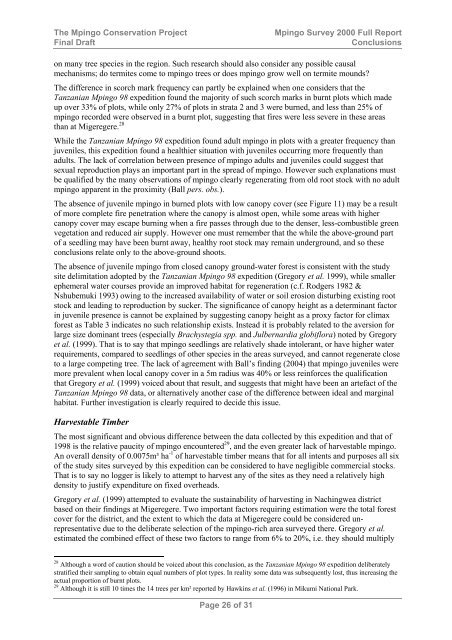the Mpingo Conservation Project - Coastal Forests of Kenya and ...
the Mpingo Conservation Project - Coastal Forests of Kenya and ...
the Mpingo Conservation Project - Coastal Forests of Kenya and ...
Create successful ePaper yourself
Turn your PDF publications into a flip-book with our unique Google optimized e-Paper software.
The <strong>Mpingo</strong> <strong>Conservation</strong> <strong>Project</strong><br />
Final Draft<br />
<strong>Mpingo</strong> Survey 2000 Full Report<br />
Conclusions<br />
on many tree species in <strong>the</strong> region. Such research should also consider any possible causal<br />
mechanisms; do termites come to mpingo trees or does mpingo grow well on termite mounds?<br />
The difference in scorch mark frequency can partly be explained when one considers that <strong>the</strong><br />
Tanzanian <strong>Mpingo</strong> 98 expedition found <strong>the</strong> majority <strong>of</strong> such scorch marks in burnt plots which made<br />
up over 33% <strong>of</strong> plots, while only 27% <strong>of</strong> plots in strata 2 <strong>and</strong> 3 were burned, <strong>and</strong> less than 25% <strong>of</strong><br />
mpingo recorded were observed in a burnt plot, suggesting that fires were less severe in <strong>the</strong>se areas<br />
than at Migeregere. 28<br />
While <strong>the</strong> Tanzanian <strong>Mpingo</strong> 98 expedition found adult mpingo in plots with a greater frequency than<br />
juveniles, this expedition found a healthier situation with juveniles occurring more frequently than<br />
adults. The lack <strong>of</strong> correlation between presence <strong>of</strong> mpingo adults <strong>and</strong> juveniles could suggest that<br />
sexual reproduction plays an important part in <strong>the</strong> spread <strong>of</strong> mpingo. However such explanations must<br />
be qualified by <strong>the</strong> many observations <strong>of</strong> mpingo clearly regenerating from old root stock with no adult<br />
mpingo apparent in <strong>the</strong> proximity (Ball pers. obs.).<br />
The absence <strong>of</strong> juvenile mpingo in burned plots with low canopy cover (see Figure 11) may be a result<br />
<strong>of</strong> more complete fire penetration where <strong>the</strong> canopy is almost open, while some areas with higher<br />
canopy cover may escape burning when a fire passes through due to <strong>the</strong> denser, less-combustible green<br />
vegetation <strong>and</strong> reduced air supply. However one must remember that <strong>the</strong> while <strong>the</strong> above-ground part<br />
<strong>of</strong> a seedling may have been burnt away, healthy root stock may remain underground, <strong>and</strong> so <strong>the</strong>se<br />
conclusions relate only to <strong>the</strong> above-ground shoots.<br />
The absence <strong>of</strong> juvenile mpingo from closed canopy ground-water forest is consistent with <strong>the</strong> study<br />
site delimitation adopted by <strong>the</strong> Tanzanian <strong>Mpingo</strong> 98 expedition (Gregory et al. 1999), while smaller<br />
ephemeral water courses provide an improved habitat for regeneration (c.f. Rodgers 1982 &<br />
Nshubemuki 1993) owing to <strong>the</strong> increased availability <strong>of</strong> water or soil erosion disturbing existing root<br />
stock <strong>and</strong> leading to reproduction by sucker. The significance <strong>of</strong> canopy height as a determinant factor<br />
in juvenile presence is cannot be explained by suggesting canopy height as a proxy factor for climax<br />
forest as Table 3 indicates no such relationship exists. Instead it is probably related to <strong>the</strong> aversion for<br />
large size dominant trees (especially Brachystegia spp. <strong>and</strong> Julbernardia globiflora) noted by Gregory<br />
et al. (1999). That is to say that mpingo seedlings are relatively shade intolerant, or have higher water<br />
requirements, compared to seedlings <strong>of</strong> o<strong>the</strong>r species in <strong>the</strong> areas surveyed, <strong>and</strong> cannot regenerate close<br />
to a large competing tree. The lack <strong>of</strong> agreement with Ball’s finding (2004) that mpingo juveniles were<br />
more prevalent when local canopy cover in a 5m radius was 40% or less reinforces <strong>the</strong> qualification<br />
that Gregory et al. (1999) voiced about that result, <strong>and</strong> suggests that might have been an artefact <strong>of</strong> <strong>the</strong><br />
Tanzanian <strong>Mpingo</strong> 98 data, or alternatively ano<strong>the</strong>r case <strong>of</strong> <strong>the</strong> difference between ideal <strong>and</strong> marginal<br />
habitat. Fur<strong>the</strong>r investigation is clearly required to decide this issue.<br />
Harvestable Timber<br />
The most significant <strong>and</strong> obvious difference between <strong>the</strong> data collected by this expedition <strong>and</strong> that <strong>of</strong><br />
1998 is <strong>the</strong> relative paucity <strong>of</strong> mpingo encountered 29 , <strong>and</strong> <strong>the</strong> even greater lack <strong>of</strong> harvestable mpingo.<br />
An overall density <strong>of</strong> 0.0075m³ ha -1 <strong>of</strong> harvestable timber means that for all intents <strong>and</strong> purposes all six<br />
<strong>of</strong> <strong>the</strong> study sites surveyed by this expedition can be considered to have negligible commercial stocks.<br />
That is to say no logger is likely to attempt to harvest any <strong>of</strong> <strong>the</strong> sites as <strong>the</strong>y need a relatively high<br />
density to justify expenditure on fixed overheads.<br />
Gregory et al. (1999) attempted to evaluate <strong>the</strong> sustainability <strong>of</strong> harvesting in Nachingwea district<br />
based on <strong>the</strong>ir findings at Migeregere. Two important factors requiring estimation were <strong>the</strong> total forest<br />
cover for <strong>the</strong> district, <strong>and</strong> <strong>the</strong> extent to which <strong>the</strong> data at Migeregere could be considered unrepresentative<br />
due to <strong>the</strong> deliberate selection <strong>of</strong> <strong>the</strong> mpingo-rich area surveyed <strong>the</strong>re. Gregory et al.<br />
estimated <strong>the</strong> combined effect <strong>of</strong> <strong>the</strong>se two factors to range from 6% to 20%, i.e. <strong>the</strong>y should multiply<br />
28 Although a word <strong>of</strong> caution should be voiced about this conclusion, as <strong>the</strong> Tanzanian <strong>Mpingo</strong> 98 expedition deliberately<br />
stratified <strong>the</strong>ir sampling to obtain equal numbers <strong>of</strong> plot types. In reality some data was subsequently lost, thus increasing <strong>the</strong><br />
actual proportion <strong>of</strong> burnt plots.<br />
29 Although it is still 10 times <strong>the</strong> 14 trees per km² reported by Hawkins et al. (1996) in Mikumi National Park.<br />
Page 26 <strong>of</strong> 31
















